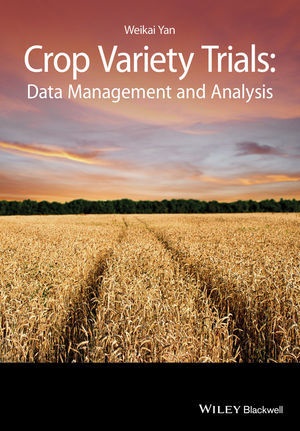Condividi
Fr. 219.00
W Yan, Weikai Yan, Yan Weikai
Crop Variety Trials - Data Management and Analysis
Inglese · Copertina rigida
Spedizione di solito entro 1 a 3 settimane (non disponibile a breve termine)
Descrizione
Variety trials are an essential step in crop breeding and production. These trials are a significant investment in time and resources and inform numerous decisions from cultivar development to end-use. Crop Variety Trials: Methods and Analysis is a practical volume that provides valuable theoretical foundations as well as a guide to step-by-step implementation of effective trial methods and analysis in determining the best varieties and cultivars.
Crop Variety Trials is divided into two sections. The first section provides the reader with a sound theoretical framework of variety evaluation and trial analysis. Chapters provide insights into the theories of quantitative genetics and principles of analyzing data. The second section of the book gives the reader with a practical step-by-step guide to accurately analyzing crop variety trial data. Combined these sections provide the reader with fuller understanding of the nature of variety trials, their objectives, and user-friendly database and statistical tools that will enable them to produce accurate analysis of data.
Sommario
Preface
Part I
1. The theoretical framework of variety evaluation
1.1. Multiyear multilocation tests: each location-year combination is an environment
1.2. Heritability (H): the ability of the trials in detecting the genetic differences
1.2.1. Heritability and Experimental design
1.2.1.1. How many years and locations are needed?
1.2.1.2. Individual test: replications and field layout
1.3. Heritability and mega-environment analysis
1.4. Heritability and test location evaluation
2. Four levels of variety trial data and data analyses
2.1. Single traits
2.1.1. Single location in a single year: importance in terms of H
2.1.2. Multiple locations in a single year
2.1.3. Multiple locations in multiple years
2.2. Multiple traits
2.2.1. Independent culling
2.2.2. Independent selection
2.2.3. Index selection
3. Principles of Biplot Analysis
3.1. Matrix multiplication and biplot
3.2. Data decomposition and biplot
3.3. Singular value partition
4. GGE biplot analysis
4.1. Data centering and biplot properties
4.1.1. correlation and cosine
4.1.2. Euclidean distance and biplot distance between genotypes
4.2. The concept of "G+GE"
4.2.1. Heritability is a GGE model
4.2.2. Variety evaluation: Not G, not GE, but G+GE
4.2.3. GE may be omitted when varieties are fully tested
4.2.4. GE alone is meaningless and misleading
4.3. Data scaling and biplot properties
4.3.1. The quantitative genetics theory of indirect selection: rgh
5. Frequently asked questions in biplot analysis
5.1. Is the 2-D biplot sufficient?
5.2. What if it is not sufficient?
5.3. Is an observed difference statistically significant?
5.4. Is an observed crossover GE statistically significant?
5.5. How to conduct biplot analysis with incomplete data?
5.6. GGE biplots versus AMMI graphs
5.7. GGE biplot versus FA biplot
Part II
6. Mega-environment analysis
6.1. Identification and utilization of repeatable genotype by region interaction
6.1.1. Improve H within mega-environments
6.1.2. Improve overall productivity
6.1.3. Reduce evaluation cost
6.1.4. Inappropriate sub-region division comes with a cost
6.2. Single year approach vs. multiyear approach
6.3. Which-won-where
6.4. Which-lost-where
6.5. Test location grouping
6.6. Mega-environments can change as new varieties are introduced
7. Test location evaluation
7.1. Single year approach vs. multiyear approach
7.2. Discriminating power
7.3. Representativeness
7.4. Repeatability
8. Variety evaluation
8.1. Means and Stability
8.2. single location in a single year
8.3. Multilocation in a single year
8.4. Multiyear multilocation
8.5. Misconceptions on the use of stability
9. Multi-trait analysis and decision making
9.1. Undesirable associations among breeding objectives
9.2. Trait profiles of genotypes
9.3. Strategies on selection based on multiple traits
9.3.1. Independent culling -use only a few, critical, traits
9.3.2. Index selection
10. Variety trial database construction and utilization
10.1. Data extraction at will
10.2. Relational database
10.3. Data version from any data format
Info autore
Weikai Yan is a Research Scientist and Oat Breeder with Agriculture and Agri-Food Canada.
Riassunto
Variety trials are an essential step in crop breeding and production. These trials are a significant investment in time and resources and inform numerous decisions from cultivar development to end-use.
Relazione
"Overall, in my opinion, Crop Variety Trials: Data Management and Analysisis a highly useful practical manual of MET data management and data analysis techniques. The use of GGE biplot software developed by the author has been amply demonstrated with examples." ( Crop Science , 1 November 2014)
Dettagli sul prodotto
| Autori | W Yan, Weikai Yan, Yan Weikai |
| Editore | Wiley, John and Sons Ltd |
| Lingue | Inglese |
| Formato | Copertina rigida |
| Pubblicazione | 16.05.2014 |
| EAN | 9781118688649 |
| ISBN | 978-1-118-68864-9 |
| Pagine | 360 |
| Categorie |
Scienze naturali, medicina, informatica, tecnica
> Biologia
> Agricoltura, giardinaggio; silvicoltura, pesca, alimentazione
Landwirtschaft, Getreide, Life Sciences, Biowissenschaften, Feldfrüchte, Agriculture, Plant Genetics, Crops, Pflanzengenetik |
Recensioni dei clienti
Per questo articolo non c'è ancora nessuna recensione. Scrivi la prima recensione e aiuta gli altri utenti a scegliere.
Scrivi una recensione
Top o flop? Scrivi la tua recensione.

